Adam Yamey's Blog: YAMEY, page 54
April 22, 2024
MORE ABOUT CATS IN ISTANBUL AND SOMETHING ABOUT CATS IN MY LIFE
I HAVE ALWAYS LIKED cats. Once, when I was about 7 years old, I was in bed suffering from one of my then frequent attacks of tonsillitis. I was recovering in bed when a small black cat wandered into my bedroom.
Knowing my love of cats, my mother had bought one to cheer me up. I christened it “Crumpet”.
There was a big problem. My mother was not keen on cats. As she thought I was too young to be trusted with a tin opener and she was worried that I might cut myself on the opened tins of cat food, she became Crumpet’s feeder.
Because Crumpet knew that Mom was the source of her food, she took a liking to her, often rubbing herself against my mother’s legs. This did not please my mother, and I believe that Crumpet sensed this. After a few months, Crumpet abandoned our house, and moved into another house along our road, where she found a more appreciative host.
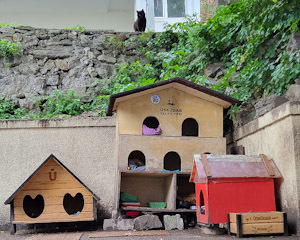 Cat shelters in Üsküdar
Cat shelters in Üsküdar We are now visiting Istanbul, which is swarming with cats. As I have already written previously, street cats seem to be well treated in this city. People put out food for them, and various organisations, including local municipalities, provide them with cosy shelters.
Today, whilst sitting in a garden outside a mosque in Üsküdar in the Asian part of Istanbul, we saw many cats – as usual. It was a cold, rainy day, and one cat, lacking in shyness, spent time keeping warm by sitting on my wife’s lap, and then mine.
What we have seen of the cats of Istanbul reinforces my affection for these furry creatures.
April 21, 2024
They came from Spain and worshipped here in Istanbul
IN 1492 THE ANDALUSIAN Arabs were thrown out of Spain. Just like some of the Jewish people who were expelled at the same time, some of the Arabs came to Istanbul, which had been under the rule of the Islamic Ottomans since 1453, when they captured the city from the Byzantine rulers.
In 1475, Fatih Sultan Ahmed converted a church in Beyoglu to a mosque, known as the Galata Mosque. Today, this mosque, whose interior feels (but does not resemble) more like that of church, is now known as the ‘Arap Camii’ (Arab Mosque). This is because the Arabs forced to leave Andalusia settled in the area around the mosque, and used it for worship.
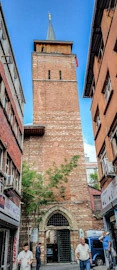
From the outside, the mosque could easily be mistaken for a church. This is because of its shape and what had once been a tall square bell tower. The tower is now topped with a conical feature, such as is found on the tops of most minarets. However at the Arap Camii, the conical object could be mistaken for a church steeple.
We visited this large mosque. The interior is rich in timber features, and looks as if it has been recently restored or renovated. An informative sign outside the mosque stated that when the building was repaired in 1913, Christian gravestones commemorating the deaths of people from Genoa (Italy) were discovered, and placed in a museum of archaeology.
We would have been unlikely to have visited this interesting mosque had we not taken a wrong turning. As the saying goes ‘every cloud has a silver lining ‘.
April 20, 2024
Istanbul is a city for cats
WE HAVE ALREADY seen many fantastic historical places in Istanbul, and I plan to tell you about some of these. But before proceeding with descriptions of landmarks in the history of Istanbul/Constantinople, let me relate something current.
Istanbul is full of cats. Wherever you look you are bound to see a cat – often looking extremely healthy. They feed both by scavenging and they are also fed by local people. They seem unafraid of humans.
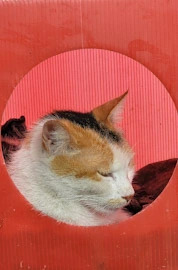
During our first three days in Istanbul, we have noticed something we had not seen before. In several places, we have seen small kennel shaped ‘sheds’ which are large enough to house one big cat or a couple of smaller ones. The floors of some of these shelters are lined with soft material including bits of old bedsheets. Most of the sheds have round holes through which the cats can enter and leave the shelters.
Another feature that makes life more pleasant for felines is that compared with many other cities I have visited, there are few dogs around in the streets.
The cats of Istanbul have much to purr about!
April 19, 2024
ONCE HE WAS THE GOVERNOR OF BOSNIA
IN THE 1980s, I used to make regular visits to see my friends who lived in the part of Yugoslavia, which is now the independent Republic of Bosnia. The influence of the Turkish occupation of the region for many years was very evident – from Turkish coffee to fine mosques.
Many years before I began travelling to Bosnia, Üsküplu Gazi Yahya Paşa (died 1506) was appointed Ottoman governor of Bosnia in 1480. He also held other important positions in the empire. He married a daughter of Sultan Beyazit II. He was philanthropic. One of the many things he did for Istanbul was to build a school which stands in Kadirga, a part of Fatih district of the city. This building with two domes still stands and was recently restored by the local municipality.
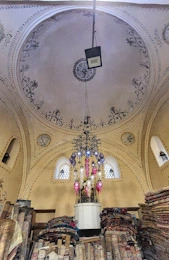
The former school now houses a shop that sells traditionally designed objects – everything from earrings to large woven carpets. The walls and domes of the interior of the building have been painted so as to recreate the place’s original decor.
This building is one of a huge number wonderful relics of the Ottoman Empire, which can be found whilst strolling around Istanbul. Fortunately, many of these old buildings have informative labels attached, with information both in English and Turkish.
April 18, 2024
At rest by the waters of the Bosphorus in a beautiful mosque
BY THE LATE SIXTEENTH century, Istanbul had become an extremely important crossroads between Asia and Europe. It was the capital of the Ottoman Empire, which by then extended over large parts of Europe, the Middle East, Egypt, and the north coast of Africa.
Part of the military force that the Sultan of the Ottomans used to maintain the empire was a group of soldiers called janissaries. These were (usually) Christian men who had been captured by the Turks, converted to Islam, and trained in military skills. They were often most effective soldiers.
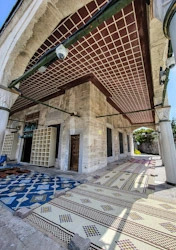
Today (16th of April 2024), we visited an elegant complex of Islamic buildings close to the waterfront at Üsküdar on the Asian shore of the Bosphorus Straits. Designed by the famous Ottoman architect Mimar Sinan (c1489-1588) in 1580, it houses a former madrasa (now used to house a library), cloisters, a mosque to which is attached the turbe (edifice housing a grave, like a dargah, as can be found in India), and a small mosque.
This complex was commissioned by Ṣemṣi Ahmed Paṣa (1516 – 1580). Amongst his numerous achievements he was, for a time, head of the janissaries. He also served as the beglerbeg (governor) of several provinces including Rumelia (which included much of the Balkans and Romania) and Anatolia.
This lovely architectural ensemble is visited by some of the many tourists who stream past it, and by many pious locals.
April 17, 2024
A toilet in the airport of Istanbul
I FIRST VISITED Turkey in the early 1960s. It was then that our family first came across squatting toilets. For want of a better name, we called these hole in the floor lavatories ‘Turkish loos’.
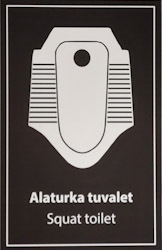
Today, in April 2024, we landed at Istanbul’s vast new airport. As nature was calling, I visited one of the many toilets in the airport building. You can imagine my surprise and satisfaction when I saw on the door to a cubicle containing a squatting toilet a sign that read in Turkish “Alaturka tuvalet”, and beneath it, the English words “Squat toilet”. So, it seems that we were right to christen these types of toilets ‘Turkish loos’.
A COMMANDER OF THE BRITISH EMPIRE AND THE ARTISTIC INTERPRETATION OF COLONISATION
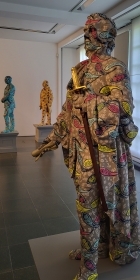
THE ARTIST YINKA SHONIBARE was awarded the prestigious CBE in 2019. In case you do not know what these three letters stand for, it is ‘Commander of the British Empire’ – not that Britain has much of, if any, empire left to boast of. For much of its long existence, places in the British Empire witnessed many injustices and inhumanities. This was especially true before the abolition of the slave trade in the early 19th century. Yinka Shonibare, who was born in London in 1962 and brought up between that city and Lagos in Nigeria, uses his artistic skills to explore Britain’s lengthy history of imperialism imaginatively and creatively. Even without knowing that he does this, his art works are in themselves visually exciting and fascinating to the viewer. The pieces on display until the 1st of September 2024 at the Serpentine South gallery in Kensington Gardens are well worth seeing both for their inherent beauty and for the way that Shonibare expresses his interpretation of Britain’s colonial past and its legacy.
For more information about the exhibition, please visit: www.serpentinegalleries.org/whats-on/yinka-shonibare-cbe-suspended-states/
April 15, 2024
Paintings by artists in India who escaped from western European artistic traditions – at the Brunei Gallery
WHENEVER I VISITED my in-laws in India, I used to admire the painting by the Bengali artist Jamini Roy (1887-1972), which used to hang in their flat. His style of painting was both modern (20th century) and at the same time almost folkloric. When our friend Bob Annibale posted on Facebook about an exhibition at the Brunei Gallery (in London’s Bloomsbury) that included Roy’s works, we could not resist visiting it, and we were glad we viewed it.
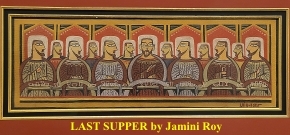
The exhibition, which continues until the 22nd of June 2024, not only contains a good selection of Roy’s works, but also others by Bengali artists working mainly between the late 19th century and the 1950s. Apart from works by Roy’s contemporaries including various members of the Tagore family, Hemendranath Mazumdar, Nandalal Bose, and Qamrul Hassan, there were also paintings by lesser-known or unknown artists who painted in the traditional late 19th century Bengali (Kalighat) style, rather than in experimental styles of the 20th century.
The emergence of modern Indian painting was a consequence of the establishment of The Government College of Art in Calcutta (in 1854). As the website of the Brunei Gallery explained, it was:
“… established by a benevolent government for the purpose of revealing to the Indians the superiority of European art.”
In the late 19th century, Indian artists working in the college began questioning the validity of Indians painting in the alien Western European fashion that was being taught them. The gallery’s website continued:
“Academic art, introduced by the British Raj, was challenged by the nationalist art movement, the Bengal School of painting, led by Abanindranath Tagore (1871-1951) and his disciples who dominated the art scene in the first decades of the twentieth century.”
It is works by these artists, who used their creations as part of their expressions of desire to see India free of British rule, that form the greater part of the show at the Brunei.
Several things particularly interested me whilst viewing the excellently curated and displayed exhibition. One was three paintings by Jamini Roy that illustrate Christian themes (e.g., the Crucifixion, the Last Supper, and the Flight to Egypt). I had not before seen any of Roy’s paintings depicting Christian stories. Another exciting discovery for me were a selection of paintings by Sunayani Devi (1875-1962), who was the sister of the artists Abanindranath Tagore and Gaganendranath Tagore, some of whose pictures are also hung in the show. These 3 siblings had a famous uncle, Rabindranath Tagore, some of whose paintings were also on show. At the exhibition, there were portraits of Rabindranath Tagore by each of his above-mentioned relatives, and one by Jamini Roy.
Yet another artist on show, whom I had never encountered, is Qamrul Hassan (1921-1988), who was born later than the other artists. Born in Calcutta before independence and the Bangladesh War (1971), he died in what is now Bangladesh. He studied at The Government College of Art in Calcutta in the late 1930s, and afterwards became involved with left wing political activities as well as his art. Later, he was active in the struggle for East Pakistan (now Bangladesh) to become independent of what was then West Pakistan. Beneath one of his creations at the Brunei, there is a quotation by Qamrul about his style of painting:
“… where Jamini Roy ends , I begin …”
And this is so easy to see in the excellent exhibition at the Brunei Gallery
I have told you what stood out for me, but although I have highlighted a few things, the rest of the exhibits are wonderful, and not to be ‘sniffed at’. After seeing the show, I thought that never before had I seen such a fine and large collection of paintings by the liberated artists either here in the UK or in India. The curators of this show deserve hearty congratulations.
Exploding with colour in a garden in London’s Richmond Park
LOCATED IN THE SOUTHWEST part of Richmond Park is one of London’s floral miracles: This year (2024), The Isabella Plantation is almost at its colourful best now (we visited it on the 12th of April) – a little earlier than usual. The camellia, azalea, and rhododendron bushes have exploded into flower alongside many other flowering plants. As you walk through the plantation, clouds of different coloured flowers seem to burst into view. Often two bushes of the same kind, but with different coloured flowers, have been planted together so that their blooms mix together to form an exciting ‘tapestry’ of flowers and contrasting hues.
During our latest visit, we were fortunate to have arrived at the right time to see some bluebells, but they were not close enough to each to seem like a carpet. However, they pale into insignificance in comparison with the flowering bushes, which have been skilfully planted so as to provide the viewer with three-dimensional, multi-coloured, natural works of art. On our recent walk around the Plantation, the morning sun (between 745 and 900 am) was shining brightly, enhancing the vividness of the flowers’ colours. Filtering through the trees, the sunlight created splashes of light on the flowers, producing an interestingly dappled effect. And some petals had sunlight shining through them, creating a lovely sight.
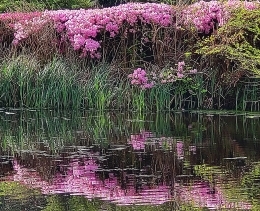
There are three ponds in the Plantation. The largest is Peg’s Pond. Next largest and at a higher altitude is Thomsons Pond, which is surrounded by a few flowering bushes. The most magnificent pond is the smallest of the three. It is the Still Pond. It is almost surrounded by azalea and rhododendron bushes. When they are in flower, their incredibly exuberant blooms are reflected in the mirror-like water of the Still Pond. This amazing effect must be seen to be believed. We saw a few mandarin ducks in the pond. As they swam, they created ripples on the surface of the pond. The gentle undulations of the water surface create interesting shimmering reflections of the firework-like flowers on the bushes next to the pond.
As on previous occasions, we parked in the free Broomfield car park, which is a short, pleasant walk away from the Plantation. Next to this carpark there is a café, which sells snacks at rather outrageously high prices. Optimistically, I hope that some of the profit goes to maintaining the Plantation.
Seeing the resplendent display of colour in the Plantation provides a pleasant distraction from the many disturbing things that are happening in many places in the world beyond the boundaries of Richmond Park.
April 14, 2024
A GARDEN IN HAMPSTEAD WITH A FASCINATING HISTORY AND WONDERFUL PLANTS
GAINSBOROUGH GARDENS IS a cul-de-sac that leads southeast from Hampstead’s Well Walk, not far from one of the former homes of the artist John Constable. Houses are arranged around an attractive sloping oval garden, which was once part of the grounds of Hampstead’s once famous, now defunct, spa water centre and resort – the lost since demolished Long Room, which I have described this in my book “Beneath a Wide Sky: Hampstead and its Environs” as follows:
“These extensive premises were demolished in 1882 to make way for an estate of residential buildings. The former Pump Room and Assembly Room occupied a plot that is bounded by Well Walk, East Heath Road, and Gainsborough Gardens. Present day Gainsborough Gardens runs around an oval open space, which is shown as a pond in the gardens of the former Pump Rooms on an 1866 map. The pond was later filled in.
At the corner of Gainsborough Gardens and Well Walk, there is a tall building with attractive neo gothic windows. This was built in about 1704. Next to this house, but separated from it by Gainsborough Gardens, stands Wellside, a house built in 1892 on the site of the Pump Room.”
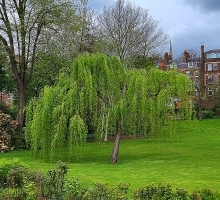
Yesterday, the 10th of April 2024, we visited Gainsborough Gardens with a friend of ours who introduced us to the friendly and highly informative couple, Adrian and Lynn, who look after the common garden within the oval. They had been the gardeners employed by the renowned pianist Katharina Wolpe (1931-2013), who had taken a great interest in the planting and planning of the oval garden. She had lived in Wellside, the house mentioned above. The gardeners told us that when she died, according to her wishes, she had bequeathed the plants in her garden to them, and they have since planted many of them in the oval garden.
Another famous person resided in Gainsborough Gardens. We were informed. That the author John le Carré (1931-2020) had lived in a house on the southwest part of the oval. As yet, there is no commemorative plaque for either him or Katharina Wolpe. According to Wikipedia, other notable residents of the Gardens included:
“ The family of songwriter Gary Osborne … The women’s suffrage campaigner Elizabeth Knight … The historian Bernard M. Allen … The Labour MP Arthur Greenwood … The former Governor of Northern Nigeria, George Sinclair Browne … Archibald Chisholm, the oil executive and former editor of the Financial Times … CE Maurice, who helped preserve Parliament Hill Fields and limit the expansion of construction onto nearby Hampstead Heath.”
Gainsborough Gardens, despite being a private ‘road’, is freely open to the public, and its centrally located garden is a delight to see.
[My book about Hampstead is available as a paperback and Kindle from Amazon:
https://www.amazon.co.uk/BENEATH-WIDE-SKY-HAMPSTEAD-ENVIRONS/dp/B09R2WRK92 ]



